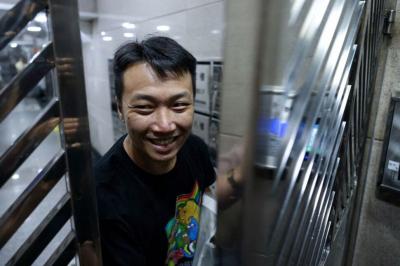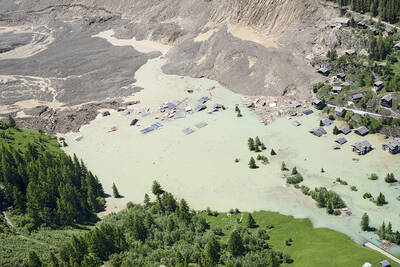Candido Figueredo sits on his bullet-riddled porch holding the tools of his trade: a reporter’s notepad, a mobile phone and a black 9mm submachine gun.
“I’m a rare species of journalist,” says Figueredo, the regional correspondent of Paraguay’s largest daily newspaper, ABC Color, who also boasts a 24-hour security detail and a collection of 11 bones and two human skulls he has personally dug up from clandestine cemeteries.
After seeing his newsroom machine-gunned twice and suffering a barrage of death threats as the result of his reports on organized crime in the border region between Paraguay and Brazil, Figueredo is taking no chances.
“I’m not an idealist, I’m a pragmatist. I don’t want to become a martyr,” he says. “I’m a product of the environment in which I’m working. If a drug trafficker is going to shoot me, I won’t hesitate in shooting him first. I’d prefer to kill him than to die.”
Figueredo, probably South America’s most heavily armed journalist, also covers one its most perilous news beats.
The last 15 years have seen Pedro Juan Caballero — a dusty town where drugs are cheap and life cheaper — transformed into Ground Zero for South American gangsters, known here as “peces gordos” or “big fish.”
“I consider Paraguay my second fatherland,” Brazil’s most notorious drug lord, Fernandinho Beir-Mar, told Figueredo in a 2003 phone interview while he was on the run from police.
Authorities openly admit that Paraguayan and Brazilian traffickers have overrun Pedro Juan Caballero, putting this town of just under 90,000 residents at the center of one of South America’s most important trafficking routes.
“We have information that more and more people are working in this [area],” says Juan Bartolome Ramirez, an ally of Paraguay’s leftist President Fernando Lugo and governor of Amambay state, which is at the heart of the marijuana growing region and is an entry point for Bolivian, Peruvian and Colombian cocaine and weapons.
“If the traffickers lose 1,000kg [of cocaine to the border police], 20,000kg are getting through,” he says.
The trade in illegal weapons is also booming along the border, fueling bloody shoot-outs between cocaine traffickers and police thousands of kilometers away in the slums of Rio de Janeiro.
“All of the guns that come through here are all going to the favelas,” Figueredo says. “Pistols, machine guns, anti-aircraft weapons. Everything.”
The recent shooting down of a police helicopter in Rio de Janeiro has cast the spotlight on places such as Pedro Juan Caballero, along 16,000km of “dry border” between Brazil and its neighbors. Police in Rio say they have seized nearly 800 rifles since January 2007 and 3,500 firearms since 2000. Many are thought to have passed through the town.
Last month, Brazilian authorities announced they were sending 20 members of the National Security Force to beef up security on the border, creating an anti-trafficking base close to Pedro Juan Caballero. Paraguayan authorities say much more is needed.
“We can’t control it all,” said special agent Mariano Baez, who heads a 12-man US-backed anti-drug taskforce in Pedro Juan Caballero.
Baez said the profits involved in drug and gun trafficking were simply too great.
“Here an AR-15 assault rifles costs between US$3,000 and US$5,000. A light assault rifle costs US$5,000. A Glock costs US$1,500,” he says.
In Rio de Janeiro, police say such weapons can fetch up to 10 times those values.
“Here you pay 3 to 3,500 dollars per kilogram [of cocaine],” Baez said. “In Europe this cocaine is worth US$30,000 or US$40,000.”
So far this year Figueredo has recorded nearly 80 homicides, making Pedro Juan Caballero statistically one of the most murderous towns on Earth, with a homicide rate that is more than three times that of Rio de Janeiro.
Ramirez said the only solution was for Latin American leaders to rethink their drug laws.
“Cocaine is a lost war — the way we are fighting it. Brazil spends trillions and can’t solve the problem of the favelas. Mexico spends even more and they have lost control. As long as people can make millions out of cocaine, repression will not solve the problem,” Ramirez says.

Four people jailed in the landmark Hong Kong national security trial of "47 democrats" accused of conspiracy to commit subversion were freed today after more than four years behind bars, the second group to be released in a month. Among those freed was long-time political and LGBTQ activist Jimmy Sham (岑子杰), who also led one of Hong Kong’s largest pro-democracy groups, the Civil Human Rights Front, which disbanded in 2021. "Let me spend some time with my family," Sham said after arriving at his home in the Kowloon district of Jordan. "I don’t know how to plan ahead because, to me, it feels

Poland is set to hold a presidential runoff election today between two candidates offering starkly different visions for the country’s future. The winner would succeed Polish President Andrzej Duda, a conservative who is finishing his second and final term. The outcome would determine whether Poland embraces a nationalist populist trajectory or pivots more fully toward liberal, pro-European policies. An exit poll by Ipsos would be released when polls close today at 9pm local time, with a margin of error of plus or minus 2 percentage points. Final results are expected tomorrow. Whoever wins can be expected to either help or hinder the

North Korea has detained another official over last week’s failed launch of a warship, which damaged the naval destroyer, state media reported yesterday. Pyongyang announced “a serious accident” at Wednesday last week’s launch ceremony, which crushed sections of the bottom of the new destroyer. North Korean leader Kim Jong-un called the mishap a “criminal act caused by absolute carelessness.” Ri Hyong-son, vice department director of the Munitions Industry Department of the Party Central Committee, was summoned and detained on Sunday, the Korean Central News Agency (KCNA) reported. He was “greatly responsible for the occurrence of the serious accident,” it said. Ri is the fourth person

The collapse of the Swiss Birch glacier serves as a chilling warning of the escalating dangers faced by communities worldwide living under the shadow of fragile ice, particularly in Asia, experts said. Footage of the collapse on Wednesday showed a huge cloud of ice and rubble hurtling down the mountainside into the hamlet of Blatten. Swiss Development Cooperation disaster risk reduction adviser Ali Neumann said that while the role of climate change in the case of Blatten “still needs to be investigated,” the wider impacts were clear on the cryosphere — the part of the world covered by frozen water. “Climate change and